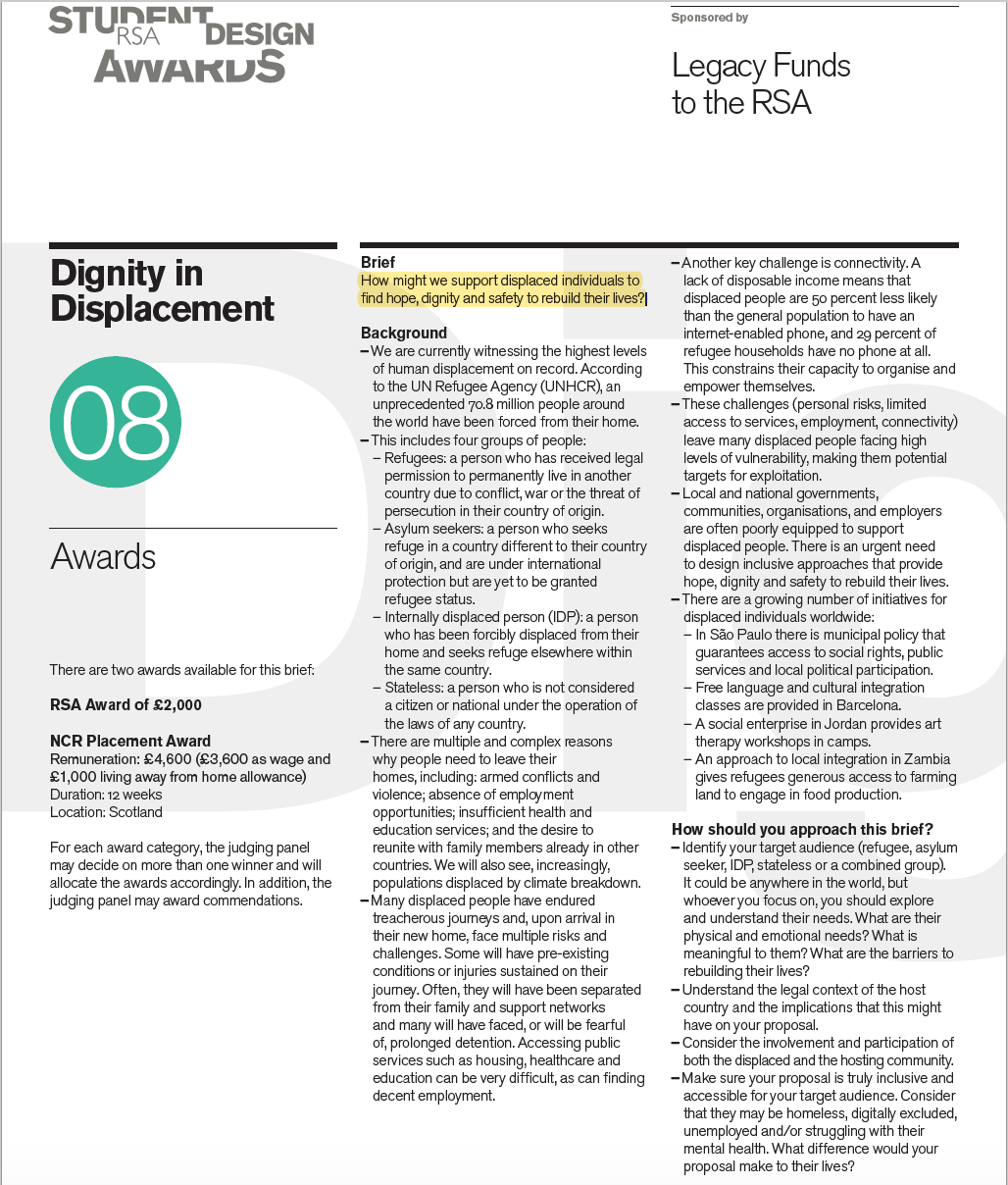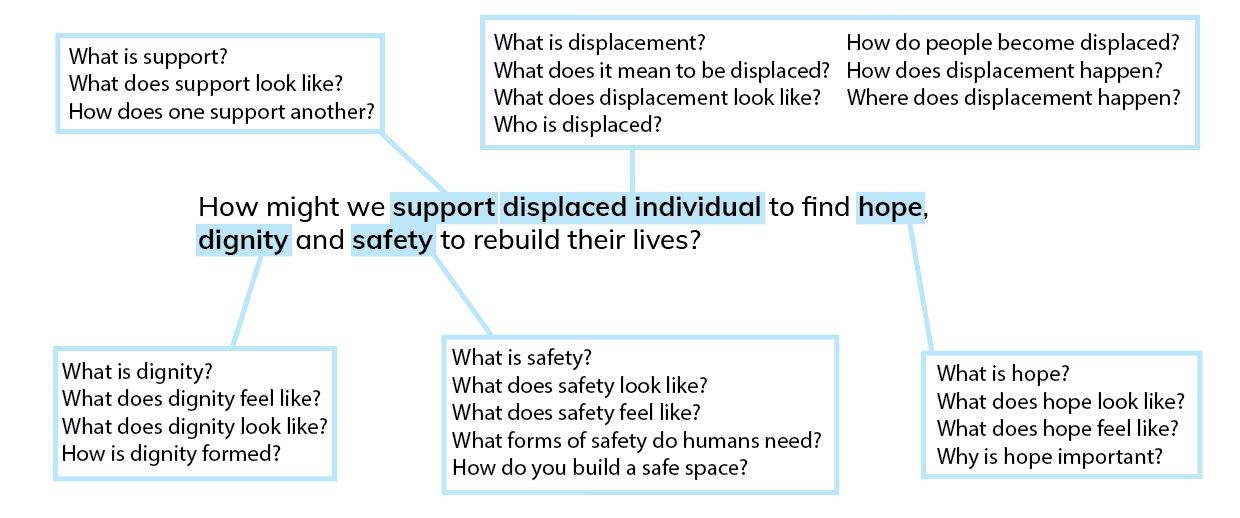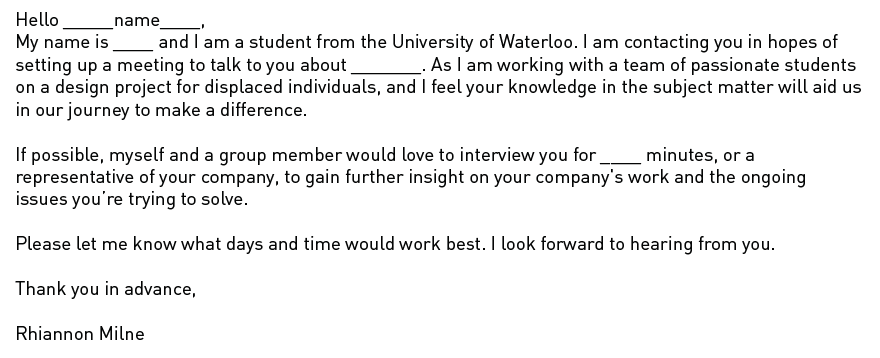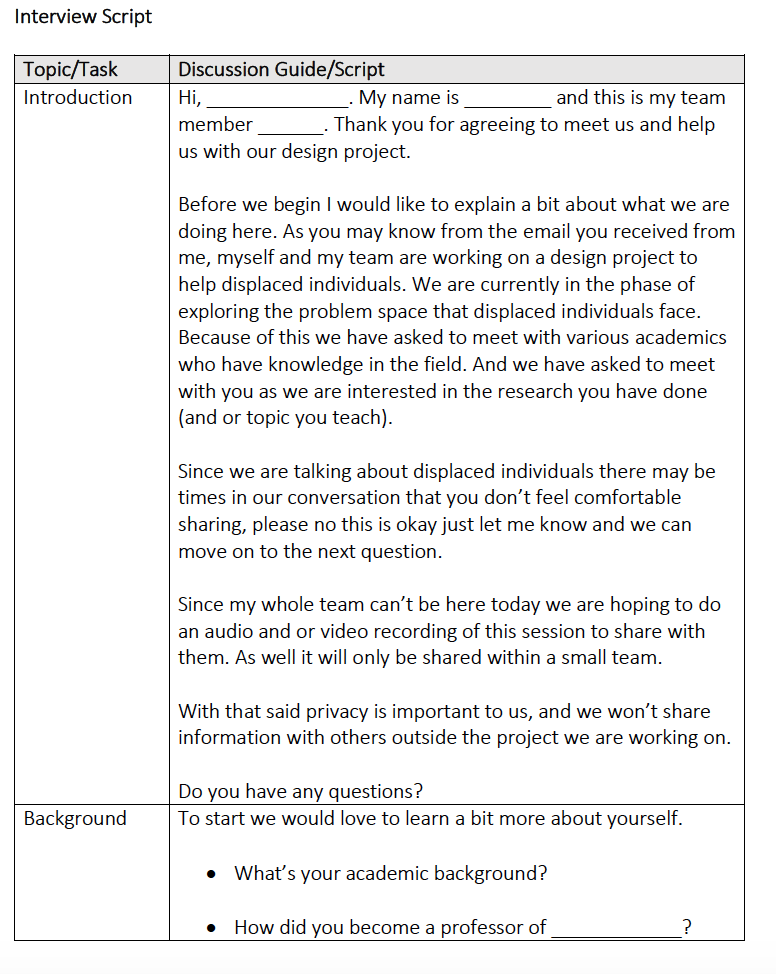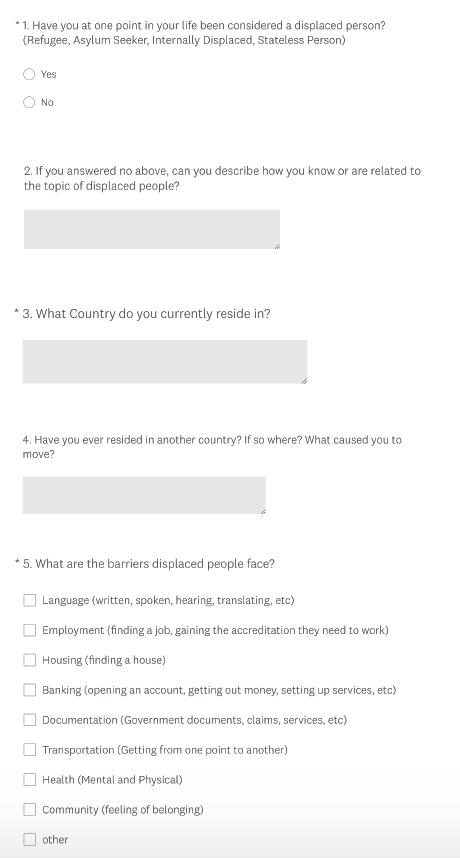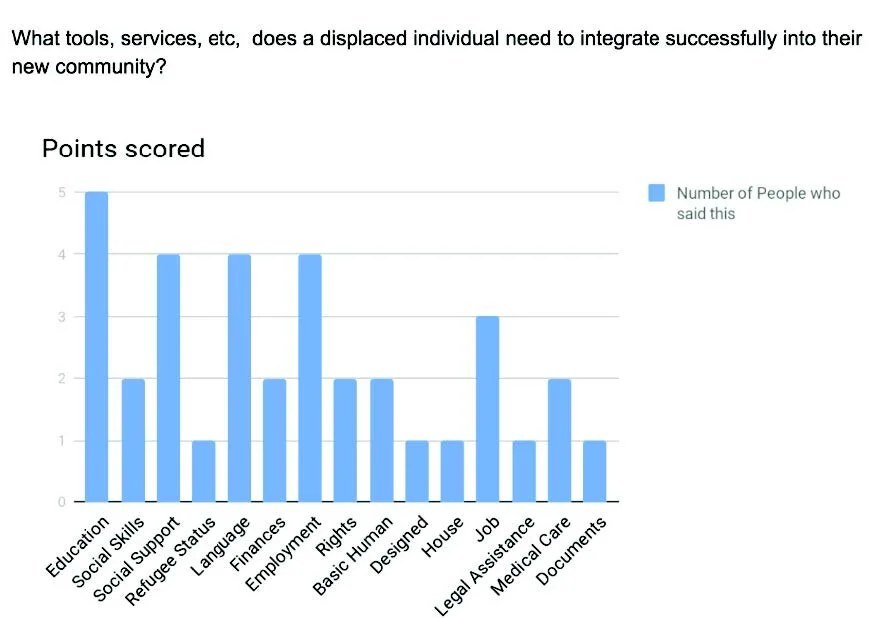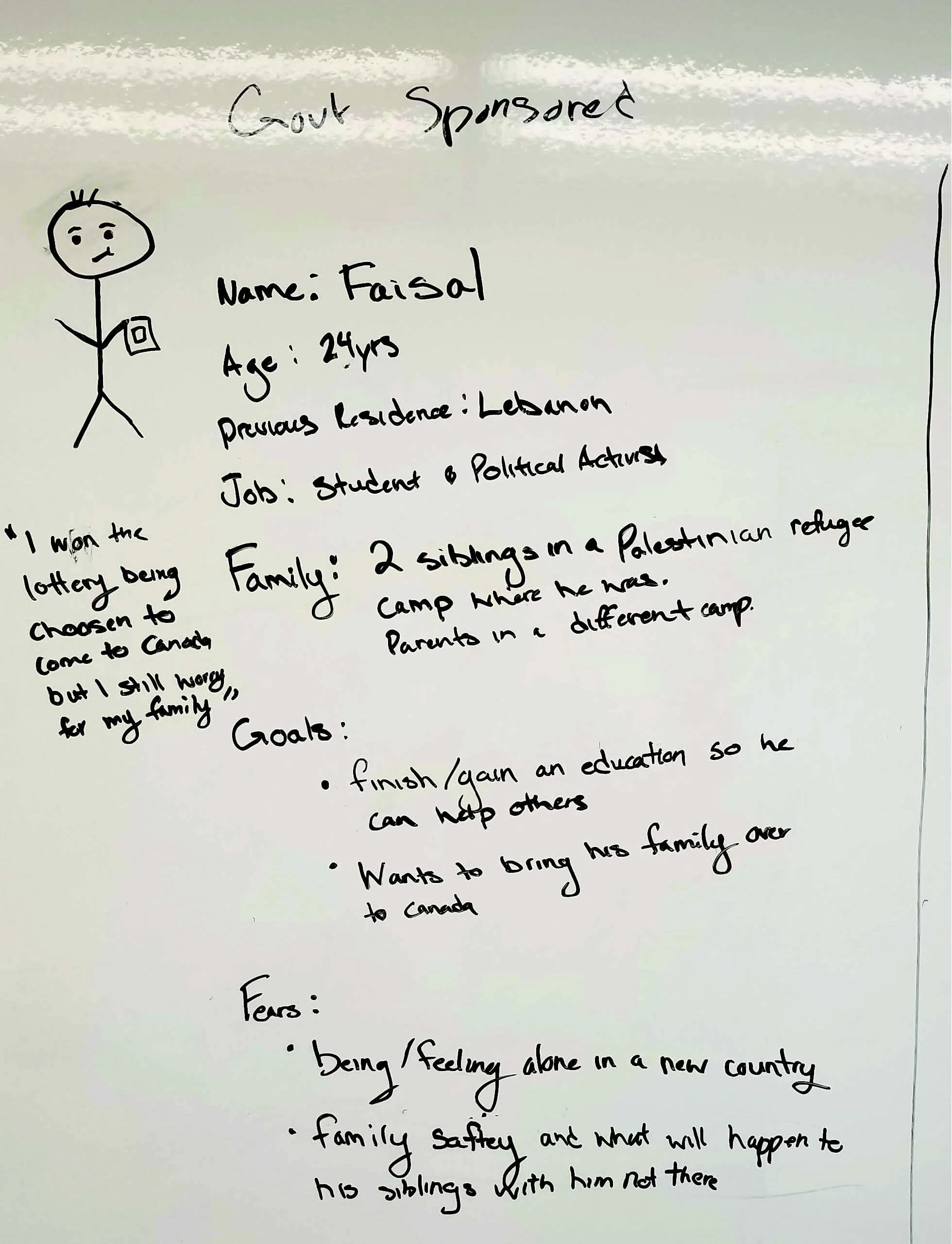
Common Grounds - Refugee Service Design
Tags: UXR/UX
Role: Lead Design Researcher
Year: 2019
Overview:
During my final year of undergrad, I participated in the Royal Society of Arts (RSA), student design competition.
I worked along side a group of peers from different disciplines to tackle the design challenge “Dignity in Displacement” for Refugees.
My team explored the current user journey of Refugees navigating the Canadian system. Through doing so we became passionate about changing this process to improve the user experience for the future and current Refugees in Canada.
RSA Deliverables:
consider social and environmental impact
have clear research and compelling insights
demonstrate systems thinking
demonstrate viability
problem statement and proposed solution
RSA Problem Statement:
How might we support displaced individual to find hope, dignity and safety to rebuild their lives?
Research
making sense of the problem space
I lead generative and evaluative research studies through the design process.
Research Methods:
desk research
subject matter expert interviews
international survey
semi-structured interviews
card sorting
co-creation activity
market fit survey
Approach:
Phase 2 - Evaluative
semi-structured interviews
concept testing
card sorting & co-creation
market fit survey
Phase 1 - Generative Research
breakdown the RSA problem statement
Subject matter interviews
international survey
Phase 1 - Generative Research
Desk Research
Broke down the RSA problem statement, as a means to start exploring the problem space.
Took the questions from the problem statement, and began conducting desk research.
I assigned all team members a list of questions to research, and gave them access to a shared research document.
Subject Matter Expert Interviews
Overview:
Prior to speaking with the end user (displaced individuals), I wanted to speak with third parties. In order to gain a history of displacement in Canada and knowledge of current refugee services.
The team hoped that by talking to experts first, we would gain knowledge of what language to use when speaking to displaced individuals. Those who may be concerned a vulnerable sector in research.
The 3 Subject Matter Experts
Academics & Researchers
Individuals located in the Kitchener-Waterloo region who currently teach or conduct research on displacement with a focus on CanadaCommunity Groups/Organization/Supports
Those who work for local groups in the Kitchener Waterloo area that offer services to displaced individualsDisplacement Entrepreneurs
Individuals or groups who have previously explored a similar problem space of displacement, who may have proposed a solution
Example: Academic recruitment email
Recruitment Email
I worked with the team to help write the recruitment emails.
Research Objective
After speaking with the team about research goals, I defined the research objective for the upcoming interviews.
Example: Academic research goal
Interview Protocol
I used the desk research conducted to influence the questions asked for each Subject Matter Expert.
I taught the team how to write interview protocols. Working through introductions, to framing questions.
Example: Academic, first page from the interview protocol
Synthesis
I lead my team in translating our user interview notes into insights through affinity mapping on a virtual research wall.
Then I began to look for pattens and form groups of notes that had a similar theme. Once the notes were grouped I began to translate them into findings and jobs to be done statements.
Finding: We found a common theme around barriers refugees face. This made us interested in further exploring these barriers through speaking with Refugees.
International Survey
Research Objective: To identify barriers Refugees face
After leaning from subject matter experts about barriers, our team wanted to validate these barriers were in fact the ones Refugees face by asking Refugees.
Since we did not have direct access to a Refugee group, we turned to social media to release a survey.
Example: A screenshot of some of the questions asked on the survey
Survey Results for the barriers refugees face, and the services they would like to see.
Personas from research
Through research our team learned that in Canada there are 3 classifications of Refugees. A Refugee claimant, family sponsored Refugee and government sponsored Refugee.
I designed a persona for each classification of refugee. Using findings from the generative research study and excerpts from user interviews. The personas helped the team understand who they were designing for, and the needs/wants of each user.
Refugee Claimant
Family Sponsored Refugee
Government Sponsored Refugee
Overall Insights & Findings
I analyzed the data for patterns and insights, from the interviews and survey data.
Discovering that many refugees need assistance/support in:
Employment
Housing
Language
Education
Documentation
A sense of Community
Medical Care
Transportation
Social Support
But through secondary research, I found that many organizations exist that address most of the issues refugees are facing.
Discovering this made me ask, what’s the disconnect? Why do refugees identify needing services that already exist?
To understand the disconnect, I looked at it from the refugees perspective:
The refugee perspective
Mapping the refugee experience, based on user interviews.
Imagine if you are placed in a new country with little knowledge of the community, transportation, or possibly the language. In this situation finding out where you can go to get help is hard. And adding to this difficulty is the services being spread out across cities making it hard to get from one to another.
Finding: Refugees struggle to access services due to language barriers, a lack of knowledge and a web of decentralized services.
Design
ideating and building
Designing the website:
Process:
sketch (flows, low fidelity, icons, visuals)
iterate
high fidelity
mock ups
Concept:
We know that young users want to consume reliable news in a fast, convenient and engaging way, but find traditional news sites time consuming. So if we redesign the site to replicate a social media platform where news stories are short, and have quick videos, then we will see an increase use from the target demographic.
sketchbook - flows
sketchbook - flows
sketchbook - icons
sketchbook - copy
low-fidelity wireframes - ideation
low-fidelity wireframes - ideation
high-fidelity wireframes - iteration
high-fidelity wireframes - iteration
high-fidelity wireframes - features and flows
mockups
Designing the print ad:
The ad will showcase the feeling of the old site on the left and the new site on the right. By demonstrating a cluttered hard to read page, contrasted by a simplistic page.
The purpose of the print ad is to demonstrate the redesign of the company’s site, showcase what has changed on the site, and to gain interest from potential users.
visual
mockup
Designing the Guerilla Advertisement:
We know that many young people take public transportation, so if we place interactive ads at waiting stations then we will increase awareness of the sites redesign and gain users.
The ad will be interactive, allowing people waiting to select news stories to play. By doing so this will also demonstrate the engaging new platform, and showcase how joy can come from consuming news media.
mockups
